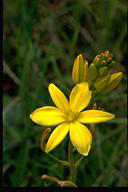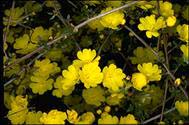

 |
Australian National Botanic Gardens
|
 |
A weekly news sheet prepared by a Gardens' volunteer.
Numbers in square brackets [] refer to garden bed Sections.
Plants in flower are in bold type.
8 October 2004
 |
|
Bulbine bulbosa
- click for larger image
|
Wonderful Spring, with heaps of flowers all through the Gardens! This week the walk is in the Rockery. Turn right from the Visitor center. After about 20 metres turn left onto a pebbled path. This is the Main path. Follow it through the Rain Forest Gully and across the bridge to the Rockery. Look to the left of the waterfall. Tucked in among the rocks is Wedge-leaved Dampiera Dampiera linearis [Section 15d]. Covering about 40 square metres is Grevillea ‘Royal Mantle’ [Section 15d] with salmon pink flowers. In the island bed above the waterfall there are Eremophila sargentii [Section 15e] with pinky mauve flowers, the red and orange pea flowered Chorizema cordatum [Section 15e] with its holly-like leaves, and the shrub Astartea sp. [Section 15e] with white star flowers. There are also many unlabelled pink or yellow paper daisies.
On the left is the lily Bulbine sp. [Section 15b], with yellow flowers. This unnamed species occurs naturally on Mt Canobolas, near orange, NSW. There is also Grampians Grevillea Grevillea confertifolia [Section 15b], with bright pink flowers. Continue on to the next bed on the left. Acacia viscidula [Section 15a] has narrow sticky leaves and pale yellow flowers. The tall shrub Daviesia elliptica [Section 15a] has yellow pea flowers. Nearby with five (not six) white petals is Asterolasia hexapetala [Section 15a]. Up the steps is the sprawling Homoranthus flavescens [Section 15a] and low Silky Guinea Flower Hibbertia sericea [Section 15a], both with bright yellow flowers.
 |
|
Hibbertia empetrifolia
- click for larger image
|
Go to the top of the steps on the right. First there is the prostrate form of Woolly Grevillea Grevillea lanigera [Section 15h] with pinky red flowers. Farther on is White Myrtle Hypocalymma angustifolium [Section 15h] with pink buds and white petals. Behind it is the taller Lavender Grevillea Grevillea lavandulacea [Section 15h] with crimson flowers. A little farther on is the yellow flowered Scrambling Guinea Flower Hibbertia empetrifolia [Section 15h] climbing through another shrub. There is also a group of Wild Rosemary Dampiera rosmarinifolia [Section 15h]. Walk along the bitumen to the next bed. Here is a red flowered waratah Telopea (speciosissima) ‘Corroboree’ [Section 15j] just starting to flower.
Below Section 15j is Section 15t. Here there is a group of white flowered candles Stackhousia monogyna [Section 15t], a group of the bright pink daisy Brachycome ‘Strawberry Mousse’[Section 15t], and the bright yellow flowered Acacia ‘Kuranga Cascade’ [Section 15t] cascading over the rocks. Look on the other side of this path. Here is the prostrate form of Coast Banksia Banksia integrifolia var. integrifolia [Section 15L], with yellow flowers. Also in this bed is the small Webster’s Mallee Eucalyptus websterii [Section 15L] with large pale yellow flowers.
Near the stream you may be lucky enough to see a Water Dragon coming out of
the water or basking on the rocks, or a bird taking a bath.
Betty Wood